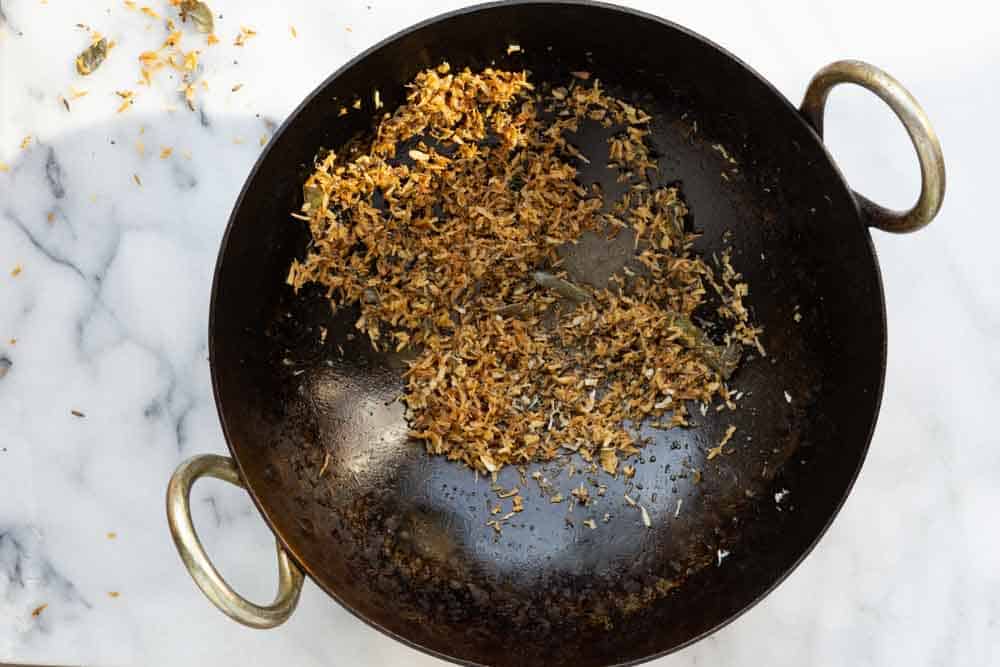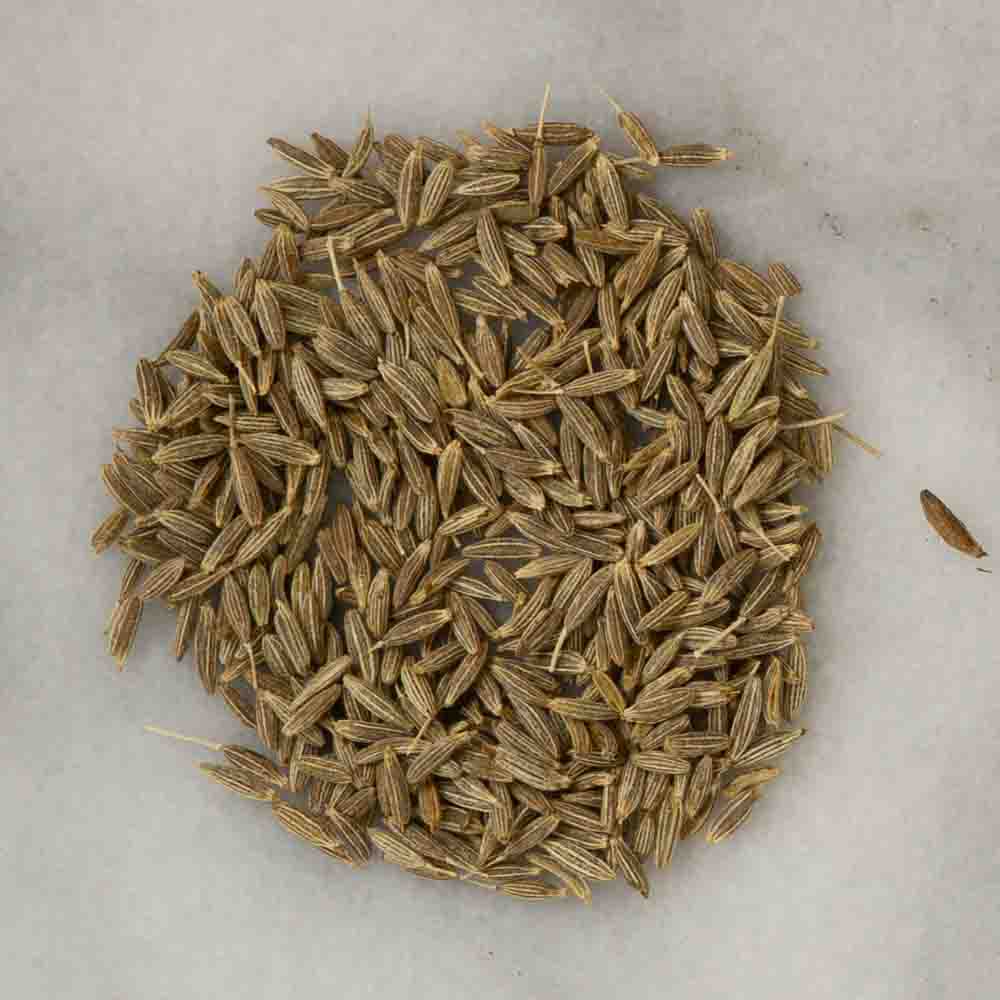Learn the science behind:

What Happens When Roasting Cumin Seeds
Something clearly happens when you roast cumin seeds. You can clearly smell the aromas rising up from a hot pan. But what causes those smells? Which chemical party causes those odors to be formed and enter my nose?
Turns out, we don’t know exactly, but, we do know that essential oils are released, and new molecules are formed. And, over time, several great ways to roast those cumin seeds have been developed.
There’s not a lot of science out there
Before we dive into the details, let’s be upfront that there won’t be a lot of scientific details. Sometimes we’re surprised by how little certain topics have been investigated in scientific literature. Roasting spices definitely is one of them. Aside from a few articles discussing the effect of dry roasting vs. using a microwave, or the health benefits of spices in general, there’s very little we seem to know about the development of flavors during roasting. If you know more or do research on the topic yourself, let us know!
That said, we do know a few things about the processes that occur while roasting cumin seeds, that can help us understand why we should even both doing so.
Cumin’s flavor comes from oils
Most of cumin’s flavor comes from essential oils contained within the seed. Combined, they only make up a few percent of the seed itself though. The remainder is made up of fibers, etc. Nevertheless, they are potent and do provide a strong flavor to a small seed.
Within these essential oils, the most prevalent flavor molecule is cuminaldehyde. It’s the main driver behind cumin’s characteristic smell and flavor. Nevertheless, you’ll also be able to find it in many other spices, such as cinnamon, be it in smaller quantities.
Aside from cuminaldehyde, a mix of molecules make up cumin’s overall complex smell and flavor. Examples of two other common aromatic molecules are terpinene and β-pinene.

During roasting, composition changes
During roasting, the heat causes a wide variety of chemical reactions to occur. What happens exactly is not yet known, it’s a complex mixture of reactions. A few scientists have tried to learn more by comparing the molecules that are present on forehand with those present at the end. It may not be clear exactly how they’re formed, but, at least it gives an inkling of the changes that occur.
They found that roasting leads to the formation of a molecule called hexanal. This is a break-down product of fats. Fats are sensitive to heat, so its formation here makes sense. Hexanal has a strong smell and aroma and contributes to a fruity, grass-like flavor. Similarly, a closely related molecule called 2-hexenal is formed.
Interestingly, most other (investigated) changes in the cumin seed involve a loss of molecules. For instance, the amounts of cinnamaldehyde and β-pinene tend to decrease during roasting.
No research has shown the formation of other, new flavor molecules. This doesn’t mean it doesn’t take place, it just hasn’t been shown. As an example, cumin seeds clearly change color during roasting. They turn brown. This points to some sort of browning chemical reaction, probably the Maillard reaction, which is often associated with the formation of new flavor components.
Roasting evaporates moisture
Aside from this limited knowledge on chemical reactions taking place, we do know one other thing for sure. Heating spices during roasting causes the evaporation of moisture. Since seeds naturally don’t contain a lot of moisture, only a little additional moisture loss is necessary to make the spices very crunchy.
To an extent, roasting cumin seeds relies on similar processes occuring as those that happen when roasting walnuts.

How to roast cumin seeds
So, unfortunately, not a lot of research has been done into what truly happens when roasting cumin seeds (or most other spices for that matter). Fortunately, we don’t always need science to still produce good food. To properly make and use roasted cumin seeds, we can add in some basic logic, common sense, and peoples’ experiences.
Roast whole seeds
Always roast whole cumin seeds. Steer away from roasting ground cumin powder. Powders have a very large surface area and contain very small, fine particles. As a result, they have a very large surface area to mass ratio and they burn very easily.
The reasoning behind buying and storing whole seeds vs. ground ones, has very similar arguments. The ground spice simply loses its flavor more quickly. Which doesn’t mean I don’t have any ground spices in my spice drawer. They still taste good and work well be it for slightly different applications.

Frying cumin seeds in fats
So far, we’ve assumed that you’re just heating the cumin seeds in a dry pan or oven. But, there is another way: frying cumin seeds in some sort of fat such as an oil or ghee.
Some may claim that the difference in roasting method makes a difference in flavor. It might well do so. We know that heating fats and oils to high temperatures will cause some chemical reactions to occur which change flavor. However, personally, we haven’t been able to find meaningful differences between roasting spices in different fats.
Deciding on roasting vs frying cumin seeds
When deciding which method to use, it’s best to look at it from a practical perspective. If you want to grind your freshly roasted spices, it’s best to roast them dry. This way, you can easily grind them up.
However, if you want to disperse that spice flavor throughout a dish, frying might be the way to go. During frying, the flavor molecules from the cumin will partially migrate into the oil. As a result, the fat in which you’ve roasted the cumin seeds gets a lot of added flavor. You can easily mix this fat through a dish, dispersing the flavor throughout.

Microwave roasting doesn’t work great
Despite the fact that several researchers have investigated roasting cumin seeds in the microwave, we did not find it to work well. The cumin seeds didn’t heat up well and even a stay in the microwave for 3 minutes, at 900W didn’t do much to the seeds at all. In the meantime, the plate on which we placed the cumin seeds has become very hot and we decided not to push it any further.
Why not roast cumin seeds in water?
There aren’t many recipes that will tell you to ‘roast’ cumin seeds in water. And there are two main reasons for (not) doing so. First, water boils at 100°C (212°F), whereas many of the chemical reactions that lead to flavor formation only really kick into gear at temperatures well above that. As such, cooking cumin seeds in water doesn’t do as much for their flavor. What’s more, most of these chemical reactions don’t happen that quickly if a lot of moisture is present.
Secondly, most of the flavor components of cumin seeds don’t dissolve well in water. On the contrary, they’re hydrophobic, meaning they do not like to sit in water. Instead, they’d much rather prefer to sit in oil. It’s why by roasting cumin seeds in oil you’ll extract a lot more of those flavors.
References
Magda A. Abd El Mageed, Amr, F. Mansour, Khaled F. El Massry, Manal M. Ramadan, Mohamed S. Shaheen, Hamdy Shaaban, Effect of Microwaves on Essential Oils of Coriander and Cumin
Seeds and on their Antioxidant and Antimicrobial Activities, Jeobp 15 (4) 2012 pp 614 – 627, link
Wikipedia, Hexanal, link
Susheela Raghavan, Handbook of Spices, Seasonings, and Flavorings, 2006, CRC Press, p. 101-103, link
America’s Test Kitchen, The Science of Good Cooking, 2012, p. 294-301, link to book review
What's your challenge?
Struggling with your food product or production process? Not sure where to start and what to do? Or are you struggling to find and maintain the right expertise and knowledge in your food business?
That's where I might be able to help. Fill out a quick form to request a 30 minute discovery call so we can discuss your challenges. By the end, you'll know if, and how I might be able to help.




